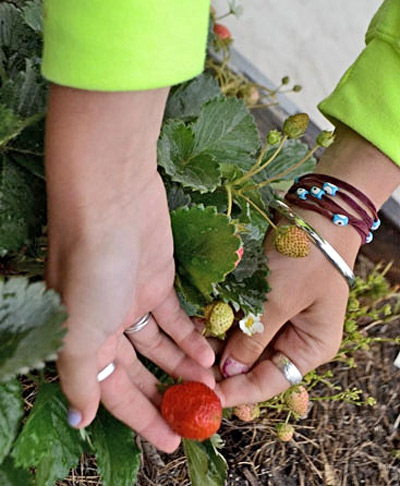Growing things connect us with Nature. Over the years, we have expanded our fruit, vegetable and flower gardens and added a small orchard. In the process, we have engaged many campers who seem to enjoy the simple but purposive process of tilling, sowing, weeding, tending and harvesting.
While gardening has been recognized as therapeutic since ancient times, it was Dr. Benjamin Rush, a signer of the Declaration of Independence and recognized as the “Father of American Psychiatry,” was first to document the positive effect working in the garden had on individuals in the 19th Century.1 Benefits from gardening and formal horticulture therapy are many. The American Horticultural Therapy Association lists 27 distinct benefits.2 The book Gardening for Children With Autism Spectrum Disorders and Special Educational Needs lists others.3 Additional studies are equally encouraging.4 5 6
We have a well-established garden at Camp Krem, consisting of seven large raised beds growing flowers, herbs, fruit and vegetables. In addition we have a newly established orchard, courtesy of Bob Mason, our wonderful neighbor who has been honored by both Santa Cruz county and the San Andreas Regional Center for his volunteer work.


Our campers, who wish to participate, plant, weed, water, and tend these gardens and harvest herbs, fruit, vegetables and flowers with great satisfaction. Our garden is made up of all raised beds so that they are accessible for our campers who use wheelchairs.

Thus far, our garden activities are ad hoc, however we plan to extend our existing informal program to provide a more structured horticultural program to our campers.
Benefits of Gardening
- Cognitive Benefits
- Enhance cognitive functioning (Kaplan & Kaplan, 1989; Cimprich, 1993; Herzog, Black, Fountaine & Knotts, 1997)
- Improve concentration (Wells, 2000; Taylor et al., 2001)
- Stimulate memory (Namazi & Haynes, 1994).
- Improve goal achievement (Willets & Sperling, 1983).
- Improve attentional capacity (Hartig, Mang & Evans, 1991; Ulrich et al., 1991; Ulrich & Parsons 1992; Ulrich, 1999; Taylor et al., 2001)
- Psychological Benefits
- Improve quality of life (Willets & Sperling, 1983; Waliczek et al., 1996)
- Increase self-esteem (Moore, 1989; Blair et al., 1991; Smith & Aldous, 1994; Feenstra et al., 1999; Pothukuchi & Bickes, 2001)
- Improve sense of well-being (Relf et al.1992; Ulrich & Parsons, 1992; Galindo & Rodrieguez, 2000; Kaplan, 2001; Jarrott, Kwack & Relf, 2002; Barnicle & Stoelzle Midden 2003; Hartig, 2003)
- Reduce stress (Ulrich & Parsons, 1992; Whitehouse et al., 2001; Rodiek, 2002)
- Improve mood (Wichrowski, Whiteson, Haas, Mola & Rey, 2005; Whitehouse et al., 2001)
- Decrease anxiety (Mooney & Milstein, 1994)
- Alleviate depression (Relf, 1978; Mooney & Milstein, 1994; Cooper Marcus & Barnes, 1999)
- Increase sense of control (Relf et al., 1992)
- Improve sense of personal worth (Smith & Aldous, 1994)
- Increase feelings of calm and relaxation (Moore, 1989; Relf et al., 1992)
- Increase sense of stability (Blair et al., 1991; Feenstra et al., 1999; Pothukuchi & Bickes, 2001)
- Improve personal satisfaction (Blair et al., 1991; Smith & Aldous, 1994; Feenstra et al., 1999; Pothukuchi & Bickes, 2001)
- Increase sense of pride and accomplishment (Hill & Relf, 1982; Matsuo, 1995)
- Social Benefits
- Improve social integration (Kweon, Sullivan & Wiley, 1998)
- Increase social interaction (Langer & Rodin, 1976; Moore, 1989; Perrins-Margalis, Rugletic, Schepis, Stepanski, & Walsh 2000).
- Provide for healthier patterns of social functioning (Langer & Rodin, 1976; Kuo, Barcaicoa & Sullivan, 1998)
- Improved group cohesiveness (Bunn, 1986)
- Physical Benefits
- Improve immune response (Hartig, Mang & Evans, 1991; Ulrich et al., 1991; Ulrich & Parsons 1992; Ulrich, 1999)
- Decrease stress (Rodiek, 2002)
- Decrease heart rate (Wichrowski, Whiteson, Haas, Mola & Rey, 2005)
- Promote physical health (Ulrich & Parsons, 1992; Kweon, Sullivan & Wiley, 1998; Cooper Marcus & Barnes, 1999; Armstrong, 2000; Rodiek, 2002)
- Improve fine and gross motor skills and eye-hand coordination (Moore, 1989)

Resources
1American Horticultural Therapy Association at http://ahta.org/horticultural-therapy
2 Benefits of Horticultural Therapy
3 Etherington, Natasha Gardening for Children With Autism Spectrum Disorders and Special Educational Needs: Engaging With Nature to Combat Anxiety, Promote Sensory Integration and Build Social Skills, Jessica Kingsley Publishers, London and Philadelphia (2012)
4 http://k.mahl.tripod.com/benefits.htm
5 Söderback, Ingrid, Söderström, Marianne and Schälander, Elisabeth, “Horticultural therapy: the ‘healing garden’ and gardening in rehabilitation measures at Danderyd hospital rehabilitation clinic”, Sweden, Vol. 7, No. 4 , Pages 245-260 (2004) reports on horticultural therapy with 46 brain injured individuals and concludes that the therapy “mediates emotional, cognitive and/or sensory motor functional improvement, increased social participation, health, well-being and life satisfaction.” Read More: http://www.informahealthcare.com/doi/abs/10.1080/13638490410001711416
6 Eden Autism Service’s website: http://www.edenflorida.org/

